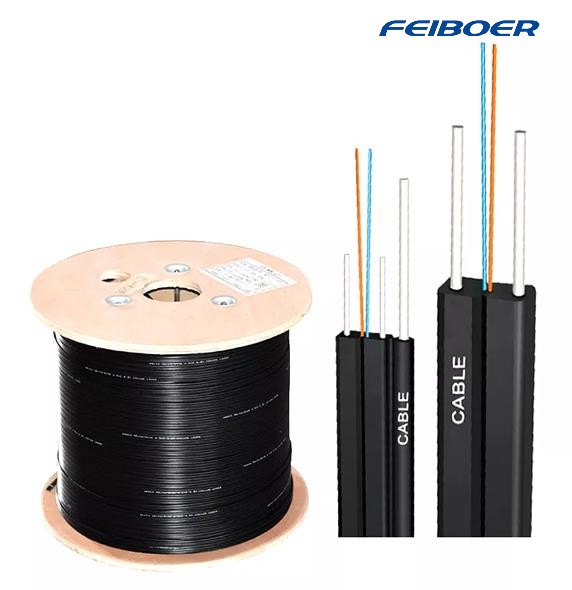1. The laying of the FTTH cable should be straight, without twisting and crossing, and should not be squeezed by external force and damaged by operation. Power lines, drop-in leather optical cables and cables of other weak current systems in the building should be laid separately.
If it cannot be satisfied, corresponding isolation and protection measures must be taken.
Steel wire reinforced FTTH cable should pay attention to grounding the metal parts in the transfer box
2. For important users or users with special requirements, protection should be considered, and different protection methods should be selected according to different situations.
3. The laying of FTTH wire optical cables should fully consider and strictly meet the requirements of "fire prevention, rodent prevention, and extrusion prevention".
4. There should be a unified mark on both ends of the FTTH cable, and the position of the connection at both ends should be indicated on the mark. Label writing should be clear, correct and correct. Labels should be made of materials that should not be damaged.
5. The turning of the FTTH cable should be uniform and smooth. The radius of curvature should be greater than 30mm when using ordinary G.652 optical fiber, and the radius of curvature should be greater than (Type A) 10mm and (Type B) 7.5mm if using anti-bending G.657 optical fiber. , (Type C) 5mm.
6. When the FTTH cable is laid, manual traction is generally used, and the traction force should not exceed 80% of the maximum allowable tension of the leather cable. The instantaneous maximum traction force shall not exceed the maximum allowable tension of the leather cable 100N.
The main traction force should be added to the reinforcement of the leather cable. After the laying of the leather cable is completed, the tension should be released to maintain a natural bending state.
7. The FTTH cable reel should be used to carry the leather cable, and the cable tray should be used when laying the leather cable, so that the leather cable reel can rotate automatically to prevent the leather cable from being entangled.
8. During the laying of the leather cable, strict attention should be paid to the tensile strength and bending radius of the optical fiber to avoid the optical fiber from being entangled, twisted, damaged and trampled.

The minimum bending radius for the laying of leather cable should meet the following requirements:
(1) The bending radius of the FTTH cable during the laying process should not be less than 40mm;
(2) After fixing, the bending radius of the FTTH cable should not be less than 15mm.
9. Shaft and bridge requirements in the building:
(1) The telecommunication shaft should pass through all floors consistently up and down, and its internal width should not be less than 600mm, and the operating distance in front of the distribution box installed in the cable shaft should not be less than 0.6m.
(2) A grounding device should be reserved in the telecommunication shaft.
(3) The installation of the trunking in the shaft should be greater than 50% of the total cable utilization.
(4) The laying of the vertical part of the home optical cable in the vertical shaft should be bundled and fixed every 1.5 meters to prevent the damage to the fiber core caused by the falling force.
10. Horizontal pipe layout requirements (weak current well to user end):
(1) The diameter of the pre-embedded pipe should be φ20mm-φ25mm. The length of the straight-line pre-embedded pipe of the concealed pipe in the building should be controlled within 30 meters, and a pass box should be added when the length exceeds 30 meters.
When the hidden pipe must be laid in a bend, its routing length should be ≤ 15 meters, and there should be no S-bend in this section. When the continuous bending is more than 2 times, a cable box should be installed. All turns are completed with pipe benders and are standard turning radii. Three links and four links are not allowed.
(2) The bending radius of the hidden pipe should be 10 times larger than the pipe diameter. When the outer diameter is less than 25 mm, the bending radius should be larger than 6 times the pipe diameter, and the bending angle should not be less than 90 degrees. The bending radius of the hidden pipe shall not be less than 6--10 times the outer diameter of the pipe.
11. When laying the leather cable, the reserved length at both ends of the leather cable should meet the following requirements: about 1m is reserved at one end of the floor optical splitter box; about 0.5m is reserved at one end of the user leather cable terminal box.
12. After the laying of the drop-in leather cable is completed, it should be tested with a light source and an optical power meter. The optical attenuation values of the drop-in drop cable at 1310nm and 1490nm wavelengths should be less than 1.5dB, such as the drop-in drop cable If the optical attenuation value is greater than 1.5dB, it should be repaired. If it has not been improved after the repair, it is necessary to re-make the optical fiber mechanical connection plug or re-lay the leather cable.
13. If the span of the outdoor FTTH cable exceeds 40 meters, a soft hanging method should be considered.
14.When laying the dark (bright) tube-type FTTH cable, firstly, when laying the dark (bright) tube, the connection at the turning corner should be connected with a hose or a crossing box can not be directly applied to the corner; when the straight-line distance exceeds 10 meters, it is better Install pass box.
04-24
202404-23
202404-23
202404-08
202404-07
202403-26
202403-26
202403-18
202403-18
202403-13
2024
